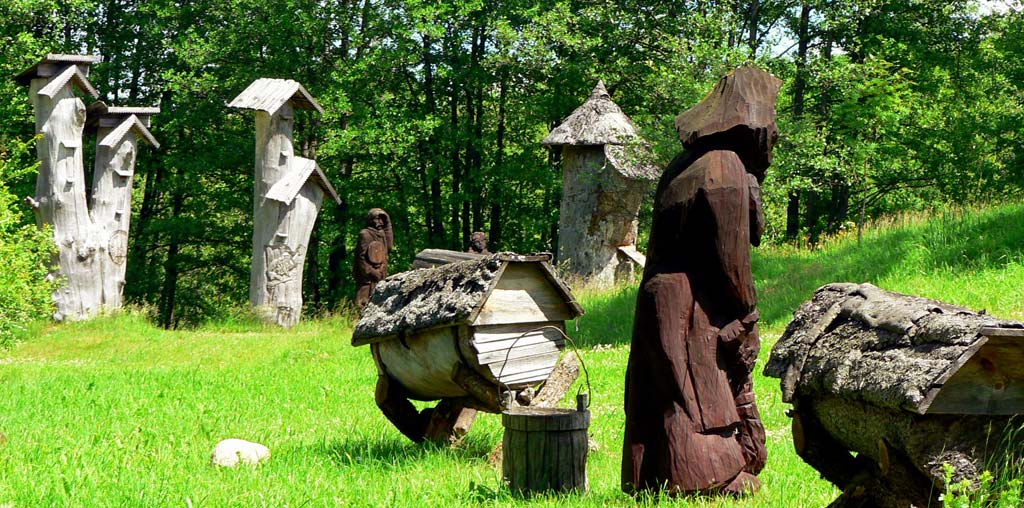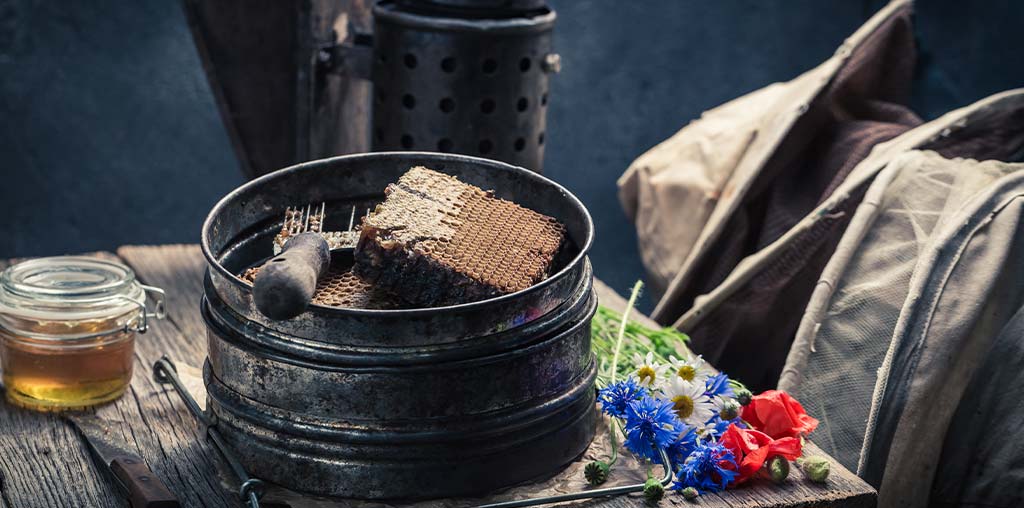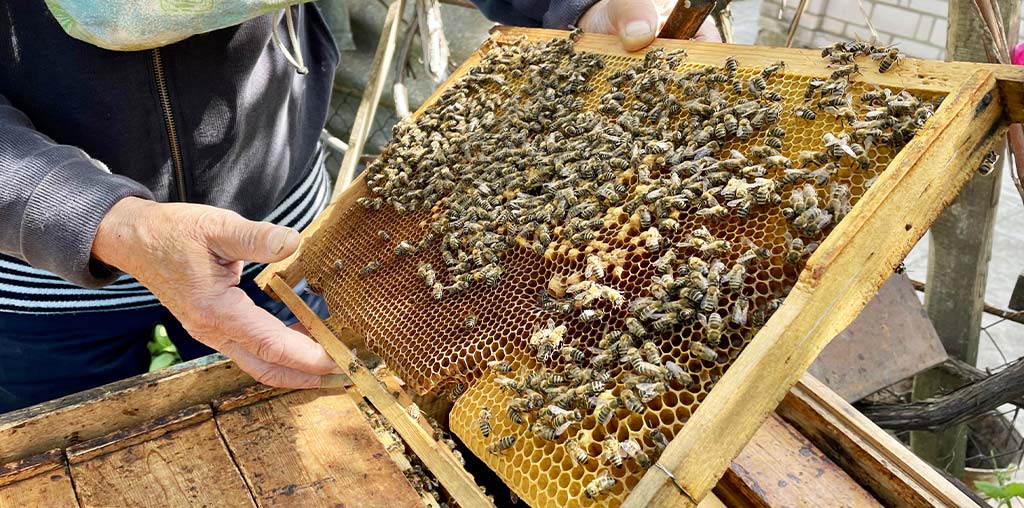
Raising bees has become increasingly popular among hobbyists, farmers, and backyard gardeners. The reasons for getting into beekeeping go beyond producing honey; in fact, raising bees is essential for pollinating a wide variety of plants, vegetables, and fruit s- ensuring you have bountiful harvests. Additionally, honeybee colonies play an increasingly crucial role in ecological stability and biodiversity conservation.
For thousands of years the practice of Beekeeping has played an important role in agricultural life. In fact, archeologists recently found evidence that advanced honey industries existed as far back as 3,000 years ago in ancient Israel.
Why Raise Bees?
Bees play an essential role in pollination and fertilization of many crops, and can be a great way to help your vegetables, flowers, fruits and other garden plants thrive. And then of course, there’s the added benefit of being able to extract your own honey and beeswax.
Fresh Raw Honey – Raw honey is not only a great sweetener, but it has many wonderful Anti-Bacterial, Anti-Viral, and Anti-Fungal Substances. It’s been used as a potent healing agent for thousands of years and has recently been scientifically proven to treat a wide variety of ailments, wounds and burns. Because of its chemical makeup, honey is a great long-term food storage item that can easily be preserved for decades.
Beeswax – In ancient times the importance of beeswax often overshadowed the production of honey. Even today, beeswax can be used in a wide variety of products and applications. From beeswax candles, which burn brighter, longer, and cleaner than typical wax candles to lotions and lip balms, beeswax is another great benefit of beekeeping.
The History and Importance of Beekeeping

Beekeeping, also known as apiculture, is the practice of managing and cultivating bee colonies for honey production, pollination, and other household benefits. Beekeeping has a rich history that dates back thousands of years, with evidence of honey production discovered in ancient civilizations all over the world.
The earliest known evidence of beekeeping comes from rock paintings found in the Cave of the Spider in Valencia, Spain, which date back 8,000 years. These paintings depict early humans climbing ladders in roder to harvest honey from wild bee colonies in trees. Other evidence of beekeeping practices has been found in Egypt, where hieroglyphs depict beekeeping and honey collection activities.
The Greeks and Romans also practiced beekeeping and wrote extensively about their techniques and methods. The Romans even made unique jars for honey storage called “dolia,” which were often decorated with bee-themed designs. Beekeeping was considered an important activity in ancient Rome, and many prominent Roman figures, including Virgil, Pliny the Elder, and Cato, the Elder, wrote about beekeeping and its benefits.
Beekeeping continued throughout the Middle Ages, as honey and beeswax were highly valued commodities for cooking, medicine, and religious activities. Monks in monasteries became early beekeepers, keeping bees in skeps, which were baskets made of wicker or straw. Honey was used in monastic medicine, and by the 13th century, beekeeping had become a common practice in monasteries throughout Europe.
The Industrial Revolution brought about significant changes in beekeeping practices, with major advances in hive design and honey extraction techniques. Langstroth hives, which are still widely used today, were invented in the 1850s by American beekeeper Lorenzo Lorraine Langstroth. This design allowed for easier management of bee colonies, more efficient honey production, and better protection against pests and diseases.
In the early 20th century, beekeeping became a commercial activity, with beekeepers selling honey and pollination services to farmers. Honey production reached record levels, and innovations in transportation allowed beekeepers to transport colonies long distances to pollinate crops. Today, beekeeping is more important than ever, as honey bees play a critical role in pollinating crops and maintaining ecosystems.
Unfortunately, honey bees face many challenges today, including habitat loss, pesticides, and disease. Beekeepers work hard to protect their colonies and support healthy bee populations, but there is still much work to be done to ensure the survival of these essential insects.
Essential Beekeeping Equipment and Materials

Beehives
Before starting a beekeeping operation, it is essential to have the right equipment and materials. The following equipment and materials are essential for beekeeping:
The beehive is where the bees reside and build their honeycombs. The equipment should meet some recommended dimensions, depending on the bee species one wants to rear. Several types of hives, including Langstroth, Top-Bar, Warre, and Observation Hives, are available for Beekeeping.
If you ask most beekeepers, they will probably tell you that the best types of hives are those that have suspended movable frames.

These frames, often referred to as Langstroth frames, make it easy to lift out and collect the honey combs. Langstroth frames are simply constructed frames that easily allow the bees to build their combs. They are probably the most popular type of honey bee hive in North America.
Other Gear You will need:
- Frames: These are supports inside the hive on which the honeycombs hang. They help maintain the structure and efficiency of the honeycombs. The recommended frame size is 9 1/8 inches by 19 in Langstroth hives.
- Protective Gear: This equipment is essential because it protects from bee stings. Protective gear includes a beekeeping suit, gloves, and a hat or veil.
- Bee Brush: This equipment helps in brushing the bees gently so that honey extraction is easier.
- Queen Separator: This device helps isolate the Queen bee to ensure she doesn’t lay eggs in honeycombs that are meant for Honey harvesting.
- Feeders: These are containers for feeding the bees with sugar or nectar syrup, which is essential during winter when food sources are scarce.
Beehive Safety: How to Prevent Getting Stung

There really is no way to 100% prevent yourself from being stung, but there are a couple of things that you can do to minimize your risk.
- Keeping Docile Breeds of Bees – When it comes to prevention, one of the best things that you can do is to keep breeds that are known for their passive nature. In the U.S., Carniolan, Russians and Italian Bees are generally considered the gentlest breeds available. These breeds are also easy to care for and are all very productive.
- ReQueening Your Hive – If your colony does seem prone to stinging, you will want to requeen your hive with a young queen. This strategy can sometimes help keep the colony in check.
- Invest in a Good Smoker – Never attempt to handle your bees or open your hives without having a smoker. Pumping smoke into and around your hive puts you in control; without it your bees will be more aggressive and will be more likely to sting.
- Beekeeping Clothing – Make sure you invest in the right type of protective clothing and gear. By always wearing a good pair of rubber bee gloves, a bee suit and a veil, you will limit your exposure to bee stings.
- Know your Limits – If you have ever had an allergic reaction to a bee sting, then obviously beekeeping is not the right activity for you. How a person reacts to bee stings can vary from person to person. For the most part, many people will eventually build up a tolerance, and can tolerate the occasional bee sting with minimal problems. Unfortunately, there is a segment of the population that can have a life threatening allergic reaction to just one sting. So before you do any type of beekeeping, you really need to be aware of how your body will react to a sting. Most family doctors can do a simple allergy test to determine your risk.
Beekeeping Resources
- Beekeeping for Beginners: The New Complete Guide to Raise a Healthy and Thriving Beehive
- The Beekeeping Bible: [5 in 1] The Ultimate Collection to Learn How to Start Your First Bee Colony to Produce Honey in Abundance
- The Backyard Beekeeper, 4th Edition: An Absolute Beginner’s Guide to Keeping Bees in Your Yard and Garden




Last year was my first year keeping bees. I had no formal training. I had very very little purchased equipment. I didn’t do most of it by the book. It’s worked out just fine.
First off my hives are topbar hives. I chose this because they were quick and easy to build at home with a table saw being the only serious tool required.
I don’t use a smoker. I use a spray bottle filled with either water or syrup. the water just knocks them out of the air and gets them to move when in the way moving bars around. the syrup did the same but slowed them down a bunch as well. I’ve been told adding something like peppermint oil to the water will help mask the alarm smell should I get stung.
I wear a heavy sweater, gloves and long pants. Remember to tuck those pants in your socks. One crawled way up my leg and I got stung near my knee. It stung because it was stuck in there and got squished when I moved. On my head I have a wide brimmed strawhat I wear in the garden. Over it my wife sewed two mosquito head covers together to make a veil. It has a flaw in that if I lean over, which you do a lot, they can get under it since it falls away from my body. I’ll add velcro hooks to it and it should then stick to my sweater.
My bees were bought locally from a man that has been trying hard to breed some disease resistance into them. The last few years local beeks have been losing between 70 and 90% of their hives each winter. My two went through last winter just fine. The guy I bought from made it through losing 30% from his hundred or so hives.
I’ve found how aggressive the bees are depends a lot on how you handle them. Bump the box once or rattle a comb and they are pissed. Be real calm and slow and they seem fine.
In the fall most beek’s harvest the honey. I figure bee’s make honey to get through the winter so maybe I’d leave them to it and get some in the spring. Last weekend I checked and there is still lots in there, I took a small comb and left the rest until the fruit tree’s bloom in the next week or so. To harvest that honey I did crush and strain. Basically mash the comb real good then put it on cheese cloth over a bucket. the next day I removed the cloth and had well filtered raw honey sitting in the bucket. Pour that in a jar, add a lid and you’re done. It tastes different and is much darker then any honey I’ve ever had from the store. It’s excellent.
For placement of my hives I put them on the roof of my carport. about 6′ from the property line and maybe 10′ from the neighbours carport. Neighbours think it’s cool and can’t wait to get some honey. Everyone in the neighbour hood approved. Responses ranged from that’s nice, to really excited. This includes the gut a few houses down that got stung twice. Both times he put his hand on or stepped on a bee. There were bees in the yards before I got mine so no idea if they’re mine or not. In the end I got stung 3 times last year. My wife once. SHe stepped on one with her bare feet. They seem attracted to the porch light and then fall to the ground by the door when they get cold. SHe went out the door to get the paper and didn’t see it. Of my 3 2 came while working the hive. One in the leg, one under the veil in the neck. Leg was annoying. In the neck caused a large local reaction that swelled up till I went to the ER and got a pill to help reduce the swelling. The 3rd sting was in the middle of december. It was sunny so the bee’s would do quick loops to go to the bathroom. Basically they’d come out do a loop go back in. One got thrown into my shirt in a gust of wind while I was coming from the car. Same as my wife’s sting, there are issues with having bee’s within 20′ of your main entrance… Also the kids always have to have shoes on since the bee’s just throw their dead out of the hive onto the ground in winter.
THis has been much longer then I intended but I wanted to point out that this hobby can be very rewarding, effectively trivially easy to do and quite inexpensive to get into. If I had started with a caught or lured swarm my total costs would be around $40. packages up here were very expensive due to the constant winter mortality rates the pro’s have been experiencing.
Great feedback. Thanks for sharing this.
My university has beekeeping classes, my friend is currently taking one for her Entomology major. I would have taken it but I’m not sure if I am allergic to bees or not because I have yet to be stung. *Knock on wood*
Great article! We’ve wanted to start beekeeping for years now but we’ve just had too many projects going on. I hope to start soon. We’ve got friends that keep bees and they love it.
Thanks!
Joe
I would recommend a book caled The Hive and the Honeybee contains all the info you could ever possibly need or want concerning beekeeping.I would also suggest breeding your own bees from surviving hives and collecting swarms and bees from the wild. Raise queens from your best hives and use these to requeen poor or agressive hives.Don’t take all of the honey when you rob the bees and watch them closely during winter or droughts and feed them sugar water or honey when their stocks run low.use no chemicals and build your own hives.Langstroth,box hives,or kenyan top bar hives all work well but for high volume honey production a Langstroth hive with plasticell foundation will out perform all other methods when using an extractor.for small operations simply hand squeezing honey comb and letting it drain overnight works well too. Not only is the honey great and wax useful ,the pollen is delicious as well.
How much is the cheapest way to build a hive? Or do you have to build one?
What is the best thing to do if a swarm of bees lights in a public area like the parking lot of a busy public mall. Is it better to leave them alone or take protective measures to protect the public?
just wondering about the world wide demise of bees,would individuals starting hives help slow the loss of bees,i dont raise bees so im ignorant of the facts,but i would like to start.
Don’t forget about checking out the “solitary bees”, such as orchard bees and Mason bees. If you are interested in honey bees as pollinators, consider the solitary bees. They are better at pollinating than the honey bee. They don’t use hives, so you can’t harvest honey. You can encourage them by building nesting boxes.
Wow didn’t realize the profession was 3000 years old! It is important to suit up properly though because they do sting pretty bad.
I have always found bees to be really interesting animals, so it is amazing to learn more about raising bees. It’s interesting how you point out that investing in a good smoker and good beekeeping clothing is vital to being successful. Like you said, bees can be aggressive and likely to sting if not handled properly, so it is important to take the right precautions. I imagine that part of this would include making sure you are using the right materials in the hive itself.